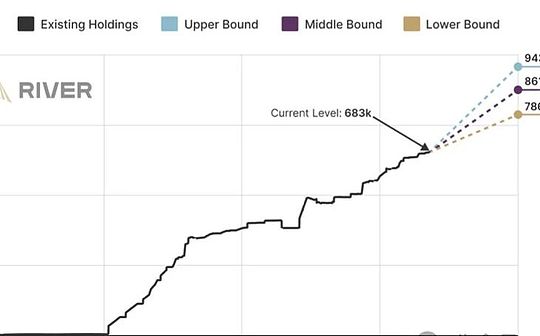Outlier Ventures: The four-year cycle driven by BTC halving is no longer established

Reprinted from jinse
04/28/2025·14DOriginal title: Bitcoin Halving. The Four Year Cycle Is Dead
Author: Jasper De Maere, head of research at Outlier Ventures, compiled by: 0xjs@Golden Finance
Four months after Bitcoin’s halving, we’ve witnessed the worst price performance since the halving so far. In this article, we will explain why halving no longer has a fundamental impact on the prices of BTC and other digital assets, and the last halving has a fundamental impact back to 2016. As the digital asset market matures, it’s time for founders and investors to get rid of the concept of a four-year cycle.
Key points of this article:
-
The halving in 2024 is the fifth period of Bitcoin halving , and the B TC price performed the worst within 125 days after the halving occurred. Prices fell -8% compared to the halving day , while the average increase in previous periods was +22%.
-
We believe that the 2016 production cut is the last time that the halving has had a significant and fundamental impact on the BTC price trend . Since then, the scale of miners' BTC block rewards has become insignificant in the context of an increasingly mature and increasingly diversified crypto market.
-
The strong performance of BTC and cryptocurrency markets after the 2020 halving is purely a coincidence, as the 2020 halving occurred during an unprecedented global capital injection period after the COVID-19 pandemic , with the U.S. money supply (M2) that year alone increasing by 25.3%.
-
Some believe that the halving-driven 4-year cycle remains in place in 2024, but the approval of BTC ETF in January 2024 drove demand ahead of schedule , resulting in a strong rise in BTC before the halving. This statement is wrong. BTC ETF approvals are demand-driven catalysts, while halvings are supply-driven catalysts, so they are not mutually exclusive.
Bitcoin prices have had a significant impact on the wider market and therefore also affect the founders’ ability to raise funds through equity, SAFT , and private or public token sale. Given the liquidity that cryptocurrencies bring to venture capital, founders must understand top-down market drivers in order to better predict financing opportunities and predict their trajectory. In this article, we will tear down the concept of a four-year market cycle to lay the foundation for exploring the real drivers of future work. Debunking the truth about the four-year cycle does not mean that we are pessimistic about the overall market. __
Let's first look at the performance of BTC price before and after the halving in the past few cycles. It is obvious that in the 125 days after the halving, the fifth cycle (2024) was the worst performing period since the halving, and it is also the only cycle when BTC price declined compared to the day of the halving.
Figure 1 : BTC price performance before and after halving in different cycles
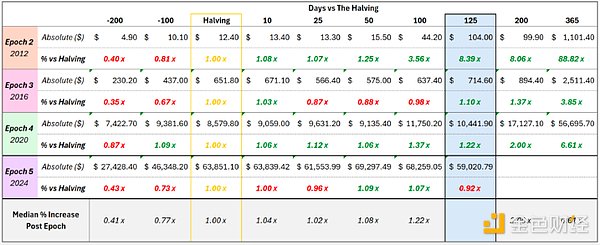
Source: Outlier Ventures
So what impact does halving have on price? In short, there are two main reasons.
-
Fundamentals: Bitcoin halving reduces new supply, creating scarcity, and prices may rise when demand exceeds limited supply. This new dynamic has also changed the economic situation of miners.
-
Psychological level: Bitcoin halving strengthens perceptions of scarcity, reinforces expectations of price surges based on historical models, and attracts media attention, which can increase demand and drive up prices.
In this article, we believe that the fundamental driver behind BTC price trends is exaggerated and has not mattered in the past two cycles . We will combine these figures to prove that the net effect of halving is not sufficient to have a significant impact on BTC prices or the broader digital asset sector.
Preliminary observation—Daily BTC block incentives
If one thing you learned from this article is:
The strongest argument for the impact of halving on the market is that in addition to reducing BTC inflation, it also affects the economic conditions of miners, causing changes in their funding management.
So, let's consider the extreme situation where all mining block rewards are sold on the market immediately. How much pressure will there be? Below, divide the total daily block reward (in USD) received by all miners by the total transaction volume (in USD) on the market to evaluate the impact.
Until mid-2017, miners had an impact on the market of more than 1%. Today, if miners sell their full BTC block rewards, they only account for 0.17% of the market transaction volume. While this does not include the BTC accumulated by miners before, it shows that the impact of BTC block rewards has become trivial compared to the overall market as block rewards decrease and the market matures.
Figure 2 : The possible impact on the market if all miners sell their daily BTC block rewards
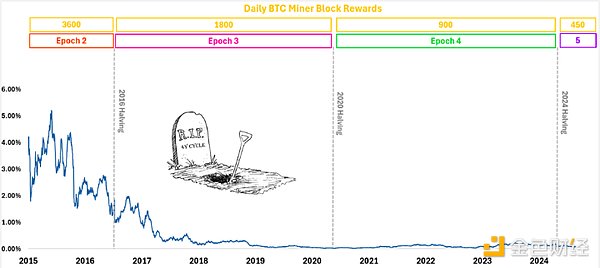
Source: Outlier Ventures
Review – Half impact
Before we proceed, let's take a quick look back. Bitcoin halving is an event that occurs approximately every four years, with miners cutting block rewards by half . This reduces the speed of new BTC generation, thereby reducing new supply to the market. The total supply of BTC is capped at 21 million , and each time it is cut in half, the speed of reaching this limit will be slower. The period between each halving is called a cycle , and historically, each halving affects the price of Bitcoin because of the decrease in supply and the increase in scarcity. All are described in Figure 3.
Figure 3 : Bitcoin halving dynamics, block rewards, total supply and cycle
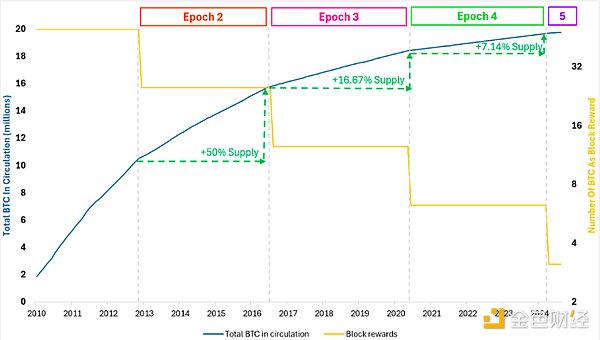
Source: Outlier Ventures
Bitcoin halving performance
Starting with what’s most important to many of us, the impact on price performance, we find that the performance after the halving in 2024 is the worst since BTC was born . As of today (September 2, 2024), the BTC transaction price is about 8% lower than the price of $63,800 on the day of the halving on April 20, 2024.
Figure 4 : BTC price performance after each halving
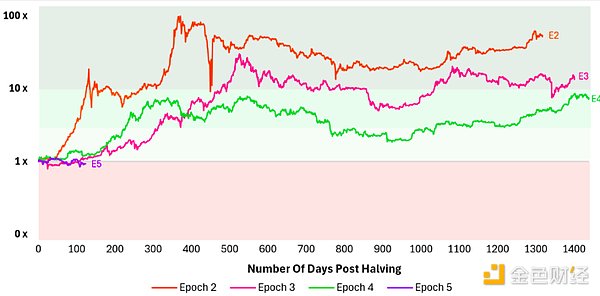
Source: Outlier Ventures
" How was the situation before the halving in 2024? " Indeed, we experienced an unusually strong trend before the halving. Looking back at the performance 200 days before the halving in 2024, we found that BTC has increased almost 2.5 times. This is almost the same as the second cycle , when BTC accounted for 99% of the total market capitalization of digital assets, and halving still made sense.
Figure 5 : BTC price performance in the first 200 days of each halving

Source: Outlier Ventures
That being said, it is also important to remember what happened during that time. In early 2024, we received approval from the BTC ETF, and since January 11, 2024, the net inflow of BTC ETFs has reached 299,000 BTC, which has greatly driven the price increase. So to be honest. The rise does not come from expectations of halving .
Figure 6 shows the BTC performance between BTC ETF approval and halving. The approval of the BTC ETF in January 2024 increased demand for BTC, resulting in a 100-day increase in the fifth cycle exceeding the average cycle increase of +17%.
Figure 6 : BTC price performance in the first 200 days of each halving
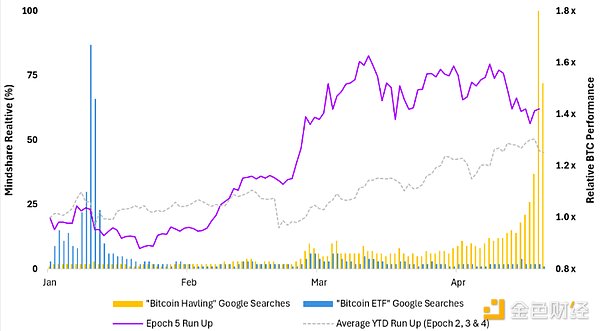
Source: Outlier Ventures , Google
Figure 7 shows the performance of BTC ETF approval and BTC halving 100 days after BTC is halved. It is obvious that the ETF approval drives price movements more significantly than halving , which can be seen from the approximately 29% gap between 100-day performance.
Figure 7 : BTC performance and ETF catalysts 100 days after halving
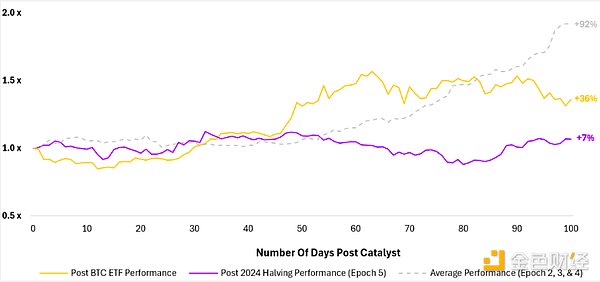
Source: Outlier Ventures
“ So the BTC ETF drives ahead of time the demand and price movements we usually see when halving!”
This is a weak argument defending the 4-year cycle. The truth is that both catalysts are independent and independent of each other. ETFs are a demand- driven catalyst, while halving is considered a supply-driven catalyst. They are not mutually exclusive, and if halving is still important, we should see significant price movements supported by this dual catalyst.
2016 is the last
I think 2016 and the 3rd cycle are the last time the halving has had a really big impact on the market. As discussed in Figure 2, the following figure illustrates the impact on the market if all miners are sold on the day they receive the block reward. As you can see, around mid-2017, this ratio fell below 1%, and today it hardly exceeded 0.20%, indicating that the impact of halving is minimal.
Figure 8 : The possible impact on the market if all miners sell daily BTC block rewards

Source: Outlier Ventures
To understand the decrease in the importance of the impact of miners' financial decisions, let's take a closer look at the different variables that work.
variable:
-
Total daily BTC block rewards – each cycle decreases (↓)
-
Daily trading volume BTC – rising as the market matures (↑)
→ Over time, block rewards will decline and the market will gradually mature, thereby reducing the relevance of miners' influence.
Figure 9 shows BTC transaction volume and miner accumulated BTC block rewards. The sharp rise in transaction volume is the real reason why miner block reward correlation becomes trivial.
Figure 9 : Daily BTC Miner Rewards and Daily Trading Volume
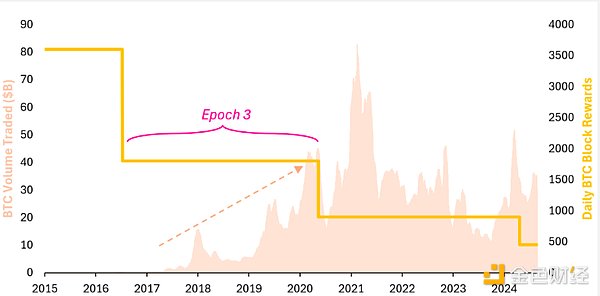
Source: Outlier Ventures
For those present at the time, it was obvious what drove the volume growth during that period. To review: After Ethereum launched and unlocked the smart contract feature in 2015, the ICO boom followed, leading to the creation of many new tokens on the Ethereum platform. The surge in new token issuances has led to a decline in the dominance of BTC. The exciting influx of new assets (i) drives trading volumes in various areas of the digital asset market, including BTC; (ii) incentivizes exchanges to mature faster, allowing them to attract users more easily and handle larger trading volumes.
Figure 10 : New ETH token issuance and BTC dominance in the third cycle
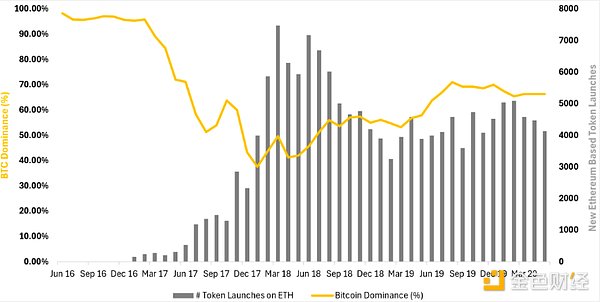
Source: Outlier Ventures
What about... what about 2020?
A lot happened in the third cycle, which logically reduced the impact of mining fund management and, in turn, reduced the impact of halving as a BTC catalyst. So what about 2020? That time, BTC rose about 6.6 times in a year after the halving. This is not because of the halving, but because of the unprecedented large amount of currency issued in response to Covid-19.
While halving is not a fundamental factor, it may have affected the price
trend of BTC from a psychological point of view. As BTC made headlines
around the halving, it provided a goal of investing in excess capital when
there were few other consumption options.
Figure 11 shows the real reason for the rebound. Just a few months before
the halving in May 2020, the U.S. money supply (M2) soared at an unprecedented
rate in modern Western history , triggering speculation and inflation in a
variety of asset classes, including real estate, stocks, private equity and
digital assets.
Figure 11 : U.S. money supply (M2) and BTC prices before and after the halving in 2020
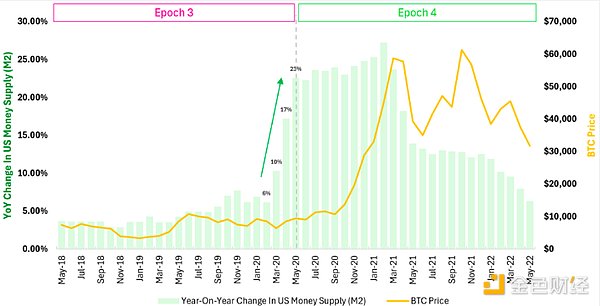
Source: Outlier Ventures , Federal Reserve Bank
In addition to flowing into BTC, it is important to realize that money printing took place after DeFi spring and then developed into DeFi summer. Many investors are attracted by the tempting earnings opportunities on the chain, investing their funds in cryptocurrencies and practical tokens to acquire this value. Because all digital assets have a strong correlation, BTC naturally benefits from it.
Figure 12 : U.S. Money Supply ( M2 ) and DeFi TVL
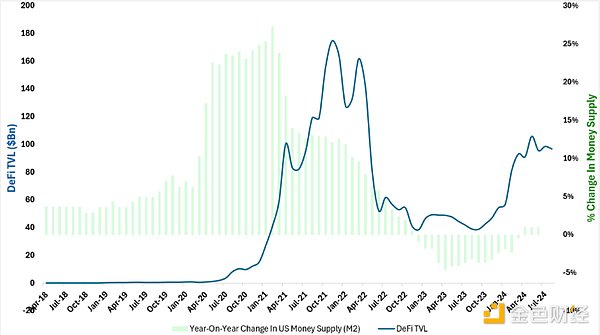
Source: Outlier Ventures , DeFiLama
As the halving took place, a number of factors driven by global helicopter money-spending policies triggered the largest cryptocurrency rebound to date, making changes in block rewards seem to have a fundamental impact on price trends.
Remaining miner supply
" What about the remaining BTC supply that miners hold in the vault? These supplies were accumulated over previous periods, when computing power was low and block rewards were higher. "
Figure 13 studies the miner supply rate, i.e. the total amount of BTC held by miners divided by the total amount of BTC supply, effectively showing how much supply the miners control. The impact of miners ' vault decisions on BTC prices is largely the result of block rewards they accumulate in the early period.
As shown, the miner supply ratio has been steadily declining, currently at about 9.2%. OTC activity has increased recently by miners selling BTC, which may be to avoid having too much impact on market prices. This trend may be due to lower block rewards, higher hardware and energy input costs and no significant increase in BTC prices – forcing miners to sell their BTC faster to stay profitable.
We understand the impact of halving on the profitability of the mining industry, and they need to adjust their capital management to stay profitable. However, the long-term development direction is clear. The impact of halving on Bitcoin price will only decrease over time.
Figure 13 : Miner supply ratio and month-on-month change rate
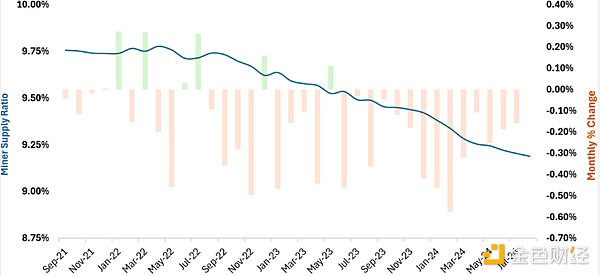
Source: Outlier Ventures , CryptoQuant
in conclusion
While halving may have some psychological effects, reminding holders to their dusty BTC wallets, it is clear that its fundamental effects have become irrelevant.
The last meaningful halving effect was in 2016. In 2020, it was not the halving that triggered the bull market, but the response to COVID-19 and subsequent printing of money.
For founders and investors trying to seize market opportunities, it is time to focus on more important macroeconomic drivers rather than relying on four- year cycles .
With that in mind, we will explore the real macro drivers behind the market cycle in the future token trendline.


